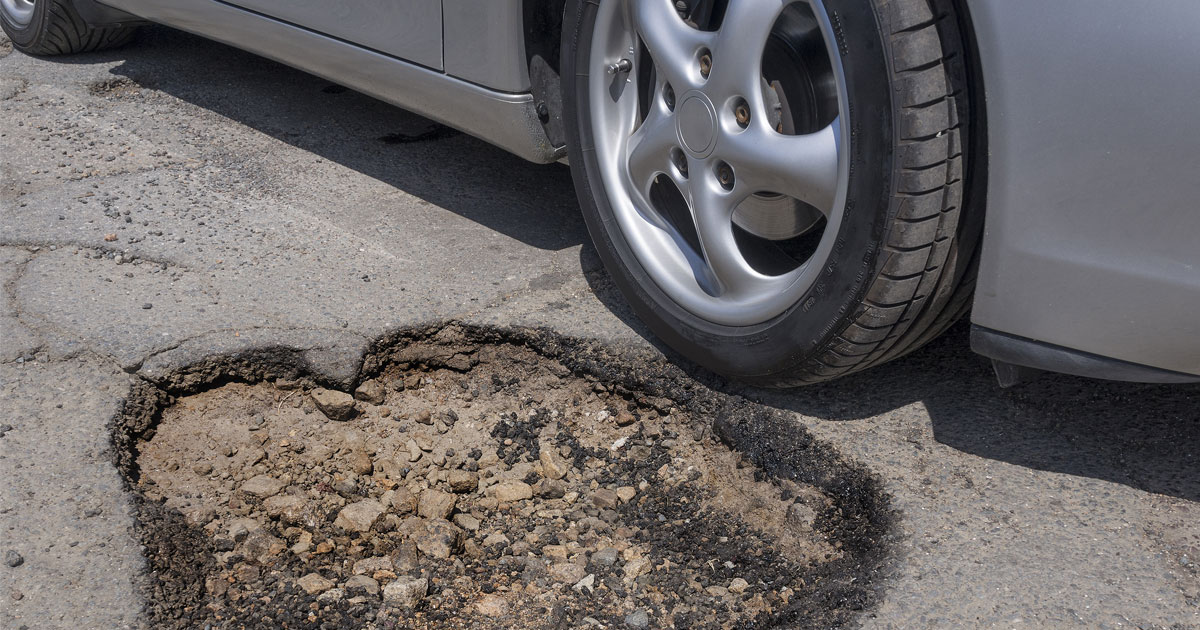Potholes are more than just a nuisance that cause car damage. Hitting a pothole is often unexpected, and the effect it has on the vehicle is jarring, unnerving, and dangerous. The sudden thud under a car’s tire can make the driver react by swerving or hitting the brakes. These impulse reactions may cause a dangerous car accident and even injuries.
As many drivers know, the rule taught in driving school to always leave two car lengths between cars is rarely observed on the road. Distracted driving has only exacerbated this problem. Therefore, when a driver in front slams on the brakes, the driver behind often slams into the braking vehicle.
On a two-way road, swerving into oncoming traffic can risk a head-on collision. If the car swerves out of the lane for road traffic and into space set aside for pedestrians or cyclists, the car could hit a person. Motorcyclists are at particular risk of being seriously injured in accidents involving potholes.
What makes potholes so dangerous is that they can be hard to detect while behind the wheel. Sometimes, they look like puddles from a distance. They are especially difficult to see at night on a dark road. Even when drivers can see potholes, it can be difficult to assess their depth and width.
What Causes Dangerous Potholes to Form?
Potholes form from normal wear on the road that causes small cracks in its surface. Water fills the cracks after it rains or snows. When temperatures reach freezing, the water expands as it turns to ice, in turn expanding the cracks along with it. When temperatures warm up, the ice thaws and the cracks remain. The water remains in place or accumulates further, and the freezing-expansion process continues. The wear and tear caused by cars and trucks that ride over the pothole further exacerbates the problem.
This freezing-expansion process is particularly evident as winter turns to spring, which is why March and April are months when potholes are at their worst in the Mid-Atlantic states.
What Can Be Done to Prevent Potholes From Forming?
Since potholes start out as simple cracks in the road surface, the freezing and expansion of the cracks can be prevented if the cracks in the road are filled before they have a chance to fill with water and freeze.
This is often difficult to do, of course, as road crews are never a welcome sight for commuters, but it is the only way to get ahead of pothole formation.
What Should I Do As a Driver to Mitigate the Risks of Potholes?
Knowing that freezing temperatures can create seriously dangerous road conditions, drivers tend to navigate winter roads with caution when snow and ice might be a factor. However, conscientious divers should not relax their caution after the thaw. When drivers are aware of the dangers created by potholes, they are more able to adopt driving behaviors that help mitigate the risks presented by dangerous potholes. Some safety-minded strategies include the following advice:
- Keep an eye out for potholes.
- Slow down.
- Do not slam on the brakes.
- Do not tailgate.
- Maintain control.
- Do not swerve.
- Avoid poorly maintained roads.
- Avoid heavy traffic.
- Inspect and repair any damage to tires right away.
Atlantic City Car Accident Lawyers at the D’Amato Law Firm Can Help You if You Have Been Injured in a Pothole Accident
When people are injured in a car accident involving a dangerous pothole, they need an experienced lawyer. The Atlantic City car accident lawyers at the D’Amato Law Firm can help. Our experienced legal team will be your advocate and fight to secure full and fair compensation. Call us today at 609-926-3300 or contact us online for a free consultation. With an office in Egg Harbor Township, New Jersey, we assist clients in Atlantic City, Linwood, Galloway Township, Cape May, Vineland, Millville, Bridgeton, Ocean City, Woodbury, and across South Jersey.


